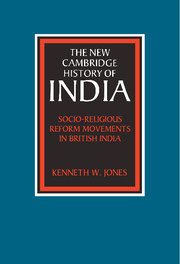Book contents
- Frontmatter
- 1 Concepts and context
- 2 Bengal and north-eastern India
- 3 The Gangetic core: Uttar Pradesh and Bihar
- 4 Punjab and the north-west
- 5 The central belt and Maharashtra
- 6 The Dravidian South
- 7 The twentieth century: socio-religious movements in a politicized world
- 8 Conclusion: religion in history
- Glossary of Indian terms
- Bibliographical essay
- Index
- THE NEW CAMBRIDGE HISTORY OF INDIA
- References
5 - The central belt and Maharashtra
Published online by Cambridge University Press: 28 March 2008
- Frontmatter
- 1 Concepts and context
- 2 Bengal and north-eastern India
- 3 The Gangetic core: Uttar Pradesh and Bihar
- 4 Punjab and the north-west
- 5 The central belt and Maharashtra
- 6 The Dravidian South
- 7 The twentieth century: socio-religious movements in a politicized world
- 8 Conclusion: religion in history
- Glossary of Indian terms
- Bibliographical essay
- Index
- THE NEW CAMBRIDGE HISTORY OF INDIA
- References
Summary
THE SETTING
Below the Gangetic basin and to the east of the Indus plain a series of steep hills and valleys run eastwards separating the northern subcontinent from its peninsular South. This central region of hills and jungles has impeded north-south movement, acting as a cultural and political barrier. On the western coast lies the Kathiawar peninsula and the immediate mainland attached to it. Together they comprise the region of Gujarat, which is partially isolated from the rest of the subcontinent. A narrow strip of land runs north and south connecting mainland Gujarat to the coast below it and through this coastal band passes the trade routes from the Gangetic plain. To the East are the Central Provinces containing a rich agricultural tract, Chhattisgarh, surrounded by hills, separated from the Deccan and the northern plains. The river valley and delta of the Mahanadi constitute the eastern region of this transitional belt, the area of Orissa. Bordered by hills to the North-West and South-West, Orissa is the site of a regional society created from a mixture of indigenous cultures, influenced from Bengal to the North, and the Telugu region to the South. Below this chain of hills is Maharashtra, an area composed of three geographic features: the Konkin coast, the western Ghats, an escarpment beginning at the Tapti River, and the Deccan, a dry inland plateau broken by numerous hills that extend south across the Godavari River, the linguistic border between the Deccan and the Dravidian South.
The culture and social system of Gujarat, the Central Provinces, and Orissa showed affinities with northern India. These areas had castes and subcastes representing all levels of the varna system. In Gujarat the two most powerful caste clusters were the merchants and members of the ruling elites, both Hindus and Muslims. A further feature of Gujarati society was the tight, hierarchical control maintained by elders within each caste. Gujarat was the home of a Hindu majority and small minorities of Jains, Muslims, and Parsis.
- Type
- Chapter
- Information
- Socio-Religious Reform Movements in British India , pp. 122 - 151Publisher: Cambridge University PressPrint publication year: 1990



